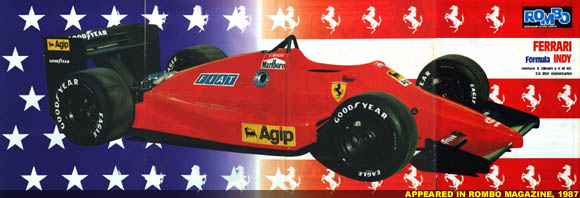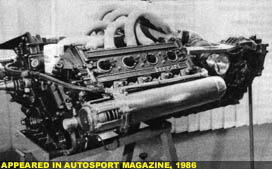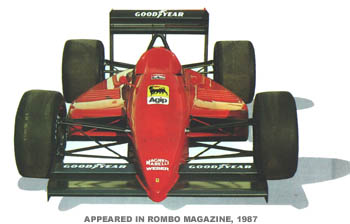 |
|
| The F1 FAQ | |
| by Mark Alan Jones, Australia | |
|
Have a question about Formula One statistics or history? Well you're not the only one, and it's about time someone came up with the answers to Formula One's most Frequently Asked Questions. Send us your questions, to faq@atlasf1.com - we may not know everything, but we will sure make the effort to find out
In late 1986 Gustav Brunner designed a Ferrari chassis to house a brand new 2.65 litre V8 turbo Ferrari engine - built to CART regulations - and the press was invited to inspect. Most journalists came away impressed; the engine held some unusual features including upward mounted exhausts, and it made the new 1.5 litre turbo V6 Formula One engine, displayed at the same time, look a little plain.
Come 1987 and Alfa Romeo, one of Ferrari's sibling in the FIAT empire, wanted to get back into serious motorsport competition. After having a look at the newly formed World Touring Car Championship, Alfa Romeo was gearing up for an attack on CART as part of marketing Alfa Romeo, and the rest of the FIAT range, in the US.
It was the old Ferrari Indycar, finding a use after all - perhaps as a test mule running in secret at Fiorano where many a strange occurrence happens.
Airboxes first made an appearance in about 1974 as Formula One cars started to evolve into the shape we know today, but by 1978 they were gone. The ground effects cars of the late 70's made certain aerodynamic demands on the cars, but none that should have precluded the use of over head airboxes. In truth, early airboxes were used for engine cooling. By the late 70's Formula One cars were achieving the same effect by having the tops of the engines protruding from the chassis. The early 80's saw the rise of the turbo charged 1.5 litre engine. Such small engines allowed cars to be created with a lower profile than in the past. This trend reached it's extreme in the 1986 Brabham BT55 skateboard. The aerodynamic penalty of an airbox was too much for the cars of the era and the turbo engines would not be able to take advantage sufficiently anyway. As naturally aspirated car began to appear again in 1988 and 1989, airboxes returned to the car's design. What the airbox achieves in modern Grand Prix cars is a mild supercharging effect - the tunnel from the intake rams air into the engine at a greater pressure than would otherwise be achieved. But the effect is not great - enough only to make it necessary to have it. In 1995 the FIA thought that 'puncturing' the air box would have a significant effect on engine power in the constant quest to reduce speeds. Before the season finished they tossed the idea aside - the difference wasn't enough to be worthwhile. Plus it would rob teams of revenue as the airbox is a highly visible part of the car. Not to mention that, without the airbox, where would the FIA mount the TV camera? Although the telecast controversy from Albert Park might suggest that there aren't any cameras on the cars anyway...
Driven - yes. Raced - no. Senna had a test with the Penske CART team during the 1992/93 off-season during one of Senna's fights with the FIA, in which the FIA were threatening to turn down Senna's superlicence. Senna tested with the Penske team - who, like McLaren, were also sponsored by Marlboro. However Senna's license was endorsed and he was back with McLaren again for the 1993 season. Imagine Roger Penske's disappointment. Imagine CART's disappointment - Senna vs Mansell in CART might well have taken quite a large chunk out of Formula One's following.
In 1991 there was a major change to the points scoring system. Up until then, 9 point was scored for a win and not every race counted towards the final World Championship score. After a few years of irregularities caused by the system (most notable in 1988 where an 11 point lead for Alain Prost was converted into a world title for Ayrton Senna), it was changed so that every race counts. Along came the change that 10 points would be given to the race winner, in order to offset the reduced emphasis on winning which that change caused. It also made sure that the constructors trophy at each race was no longer awarded to a team that finished 2nd and 3rd, thus scoring more points than the team that won the race. By the way, when the world championship first started back in 1950, the winner only received 8 points. It was changed to 9 in 1961. Up until 1959 the final point was awarded to the fastest lap rather than 6th place. That lead to the ridiculous situation of 7 drivers, (Alberto Ascari, Jean Behra, Juan Manuel Fangio, Froilan Gonzalez, Mike Hawthorn, Onofre Marimon and Stirling Moss) sharing that point in the 1954 British Grand Prix. And what do you know - Jean Behra scored 0.14 points during the 1954 season...
Refuelling was first banned in the early 80's after a spate of dangerous pit lane fires. After that, Formula One engine makers were forced to build engines that could drive the 300 kilometres distance with a set amount of fuel in the fuel tank. Drivers kept an eye on the fuel status via a readout of the fuel economy the car was achieving. However, cars did occasionally run out of fuel, or in one famous incident Alain Prost in a McLaren-Porsche finished the San Marino Grand Prix of 1985 with so little fuel, that the car was under minimum the minimum allowed weight and was disqualified from a race win. McLaren had a particular problem with fuel watch in 1991, where Ayrton Senna ran out of fuel on the last lap twice - at the British and German Grands Prix. And in the case of the rather dull French Grand Prix - where his car finished with several laps of fuel left in the tank while Senna was convinced he was almost out. After ripping some heads off in McLaren engine computer department Senna won the next three races.
Williams did produce a 6-wheeler during the 1980/81 off season that had the power being driven through both rear axles (unlike the March 6-wheeler which had the power running though only one of it's two rear axles). Alan Jones tested the car and immediately blew the doors off the lap record. But Before you could say 'whatthehellwasthat', FISA banned four wheel drive. Four wheel drive at that stage was no stranger to Formula One. The Lotus 56B was the grand experiment. It was powered by a leased Pratt and Whitney gas turbine engine. The car was difficult to drive and refused to idle, and actually had a tendency to accelerate while off throttle. The car also had four wheel drive. Dave Walker gave the cars its finest hour when in the wet 1972 Dutch Grand Prix the car was the fastest car on the track and was overhauling the leaders when its off throttle push caught the Australian out and he spun off and retired. The concept did not survive the season. This wasn't the first 4WD F1 though. Ferguson - that's right, Ferguson as in Massey Ferguson the tractor manufacturer - built a 4WD drive Formula One car in 1962 and the car was taken to Australia and New Zealand to run in the Tasman Cup series of races as a possible prelude for an attack on Formula One. The 62/63 Tasman Cup was the first in which the Europeans decide to invade the what was to become hugely popular down under series. Tasman Cup rules had engine capacity a 3 litres rather than Formula One's 1.5, which was a large part of the appeal for the Europeans. For this first season the regulars Jack Brabham (now fielding his own team) and Bruce McLaren (factory Cooper-Climax) were joined by the factory Lola-Climax team of John Surtees and Tony Maggs. The rest of the field was made up with locals (which included future F1 driver Frank Gardner and Chris Amon) in Cooper-Climax's, Cooper-Maserati's, and Brabham-Repco's. And the Ferguson-Climax. Who did Ferguson get to drive the car? Who better than the reigning world champion Graham Hill. While the Ferguson wasn't as quick as the other cars (the 4WD system was by necessity heavy) Hill's ability was able to give it some useful results. During an emotional day at Warwick Farm for the series pinnacle of the Australian Grand Prix, Hill could only manage 6th behind Bib Stillwell, David McKay, Bruce McLaren, John Surtees and the race winner Jack Brabham, how's ailing Brabham-Repco held together to a standing ovation from his home crowd. It was in the end decided that the weight of the 4WD system would be too much for the F1 cars of the time to overcome with their 1.5 litre capacity.
I think I can guess your interest in those particular drivers. To treat the question numerically: 1) Rubinho has a long way to go to beat Andrea de Cesaris figures of 208 winless starts. Also winless were Martin Brundle (158), Derek Warwick (147), Jean-Pierre Jarier (135), Eddie Cheever (132), Pierluigi Martini (119), Phillippe Alliot (109). The most races a race winner has raced before achieving his first win was Mika Hakkinen whose first win was his 96th start. 2) Barrichello has 98 starts including the 1999 Australian Grand Prix. 3) The 1995 Canadian Grand Prix was Alesi's 91st start. 4) Assuming you mean Emmerson Fittipaldi (Wilson and Christian never won races) - Emmerson Fittipaldi took a mere 4 races to win his first at the 1970 United States Grand Prix at Watkins Glen. Jose Carlos Pace took 41 races before breaking through to his only win in the 1975 Brazilian Grand Prix at Interlagos. Nelson Piquet took 24 races before winning the 1980 United States Grand Prix West at Long Beach. Ayrton Senna took 16 races before winning the 1985 Portugese Grand Prix at Estoril, although his 5th race at Monaco 1984 perhaps should have been his.
|
| Mark Alan Jones | © 1999 Atlas Formula One Journal. |
| Send questions and comments to: faq@atlasf1.com | Terms & Conditions |

 There were rumours that Ferrari would be attacking the 1987 season, then the 1988 season. Rumours were placing Andrea de Cesaris in the car for the 1987 Indianapolis 500 But the car never raced. One rumour circulating was that the car was built to put pressure on the FIA. The new engine regulations for 1989 onwards were being finalised for 3.5 litre V8 engines. Ferrari however wanted to build a V12. So they put pressure on the FIA by building an Indycar. The FIA changed the regs and V12's were allowed - and Ferrari (and Lamborghini) built their Formula One V12's. This would also allow Honda and Renault and now everyone to build V10's. The Indycar was locked away in FIAT's vault.
There were rumours that Ferrari would be attacking the 1987 season, then the 1988 season. Rumours were placing Andrea de Cesaris in the car for the 1987 Indianapolis 500 But the car never raced. One rumour circulating was that the car was built to put pressure on the FIA. The new engine regulations for 1989 onwards were being finalised for 3.5 litre V8 engines. Ferrari however wanted to build a V12. So they put pressure on the FIA by building an Indycar. The FIA changed the regs and V12's were allowed - and Ferrari (and Lamborghini) built their Formula One V12's. This would also allow Honda and Renault and now everyone to build V10's. The Indycar was locked away in FIAT's vault.
 Again journalists were invited to view the new Italian creation, some time in 1989. An all new Alfa Romeo 2.65 V8 turbo, bearing no relation to the Ferrari unit of three years previous, was unveiled connected to a March chassis. Over in the back of workshop Doug Nye spotted an all white chassis that was clearly not a March and had an Alfa Romeo logo painted on it that nobody from Alfa Romeo were prepared to talk about. It was too big to be any of the smaller formulae running in Europe and America, and the circular indentations for refuelling caps gave it away as being an Indycar chassis.
Again journalists were invited to view the new Italian creation, some time in 1989. An all new Alfa Romeo 2.65 V8 turbo, bearing no relation to the Ferrari unit of three years previous, was unveiled connected to a March chassis. Over in the back of workshop Doug Nye spotted an all white chassis that was clearly not a March and had an Alfa Romeo logo painted on it that nobody from Alfa Romeo were prepared to talk about. It was too big to be any of the smaller formulae running in Europe and America, and the circular indentations for refuelling caps gave it away as being an Indycar chassis.